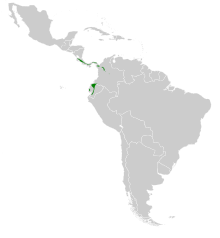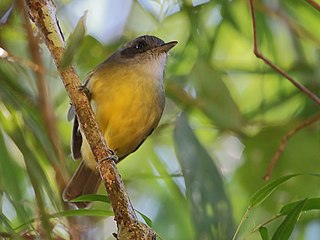
The plain antvireo is a passerine bird species in subfamily Thamnophilinae of family Thamnophilidae, the "typical antbirds". It is found in Mexico, every Central American country except El Salvador, on both Trinidad and Tobago, and in every mainland South American country except Chile, French Guiana, Suriname, and Uruguay.

The snowcap is a species of hummingbird in the "emeralds", tribe Trochilini of subfamily Trochilinae. It is found in Costa Rica, Honduras, Nicaragua, and Panama.
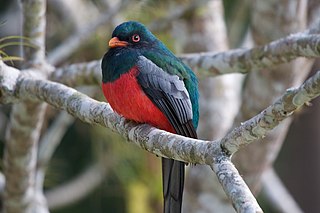
The slaty-tailed trogon is a near passerine bird in the family Trogonidae, the quetzals and trogons. It is found in Mexico, throughout Central America, and in Colombia and Ecuador.

The silver-throated tanager is a species of passerine bird in the tanager family Thraupidae. It is found in Costa Rica, Panama, Colombia, Ecuador, and northeastern Peru. It inhabits mossy forests, montane evergreen forests, tropical lowland evergreen forests and forest edges, along with tall secondary forests and disturbed habitat with remnant trees and forest. It is 13 centimetres (5.1 in) long and weighs 22 grams (0.78 oz) on average, and shows slight sexual dimorphism, with duller female plumage. Adult males are mainly bright yellow, with a silvery-white throat bordered above with a black stripe on the cheeks, black streaking on the back, and green edges to the wings and tail. Juveniles are duller and greener.
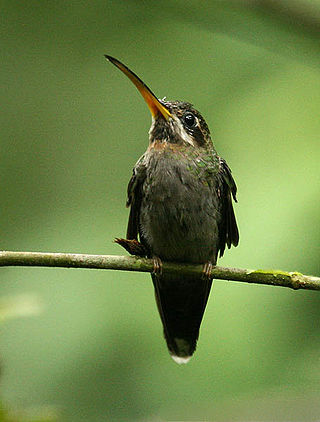
The band-tailed barbthroat is a medium-sized hummingbird that is found from southeastern Guatemala and Belize to western Ecuador and western Venezuela.

The bronze-tailed plumeleteer is a species of hummingbird in the "emeralds", tribe Trochilini of subfamily Trochilinae. It is found in Colombia, Costa Rica, Ecuador, Nicaragua, and Panama.

The white-whiskered puffbird, also called the white-whiskered soft-wing or brown puffbird, is a near-passerine bird in the family Bucconidae, the puffbirds, nunlets, and nunbirds. It is found from southeastern Mexico through Central America, Colombia, and Ecuador into Peru.

The dot-winged antwren or velvety antwren is a passerine bird in subfamily Thamnophilinae of family Thamnophilidae, the "typical antbirds". It is found in Mexico, every Central American country except El Salvador, Bolivia, Brazil, Colombia, Ecuador, French Guiana, Guyana, Peru, and Suriname.
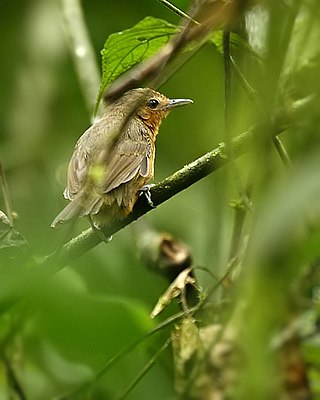
The dusky antbird or tyrannine antbird is a passerine bird in subfamily Thamnophilinae of family Thamnophilidae, the "typical antbirds". It is found from Mexico south through Central America and in Brazil, Colombia, Ecuador, French Guiana, Guyana, Suriname, and Venezuela.

The chestnut-backed antbird is a passerine bird in subfamily Thamnophilinae of family Thamnophilidae, the "typical antbirds". It is found in Colombia, Costa Rica, Ecuador, Honduras, Nicaragua, and Panama.

The slaty antwren is a small passerine bird in subfamily Thamnophilinae of family Thamnophilidae, the "typical antbirds". It is found from Mexico south through Central America, Colombia, Ecuador, Peru, and Venezuela.

The white-tipped sicklebill is a species of hummingbird in the family Trochilidae. It is found in Colombia, Costa Rica, Ecuador, Panama, Peru, and Venezuela.

The violet-fronted brilliant is a species of hummingbird in the "brilliants", tribe Heliantheini in subfamily Lesbiinae. It is found Bolivia, Colombia, Ecuador, Peru, and Venezuela.

The black-throated brilliant is a species of hummingbird in tribe Heliantheini of subfamily Lesbiinae. It lives in Brazil, Colombia, Ecuador and Peru.

The velvet-browed brilliant is a species of hummingbird in the "brilliants", tribe Heliantheini in subfamily Lesbiinae. It is found in Brazil, Guyana, Suriname, and Venezuela.
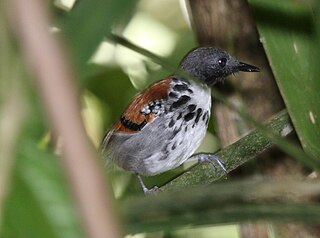
The spotted antbird is a species of bird in subfamily Thamnophilinae of family Thamnophilidae, the "typical antbirds". It is found in Colombia, Costa Rica, Ecuador, Honduras, Nicaragua, and Panama.

The southern nightingale-wren, also known as the scaly-breasted wren, is a species of bird in the family Troglodytidae. It is found in Bolivia, Brazil, Colombia, Costa Rica, Ecuador, Panama, Peru, and Venezuela.

The black-crowned antshrike is a species of bird in subfamily Thamnophilinae of family Thamnophilidae, the "typical antbirds". It is found in every Central American country except El Salvador and in Colombia, Ecuador, Peru, and Venezuela.
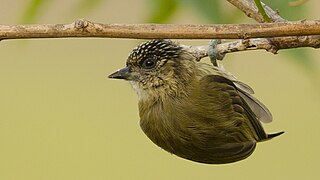
The olivaceous piculet is a species of bird in subfamily Picumninae of the woodpecker family Picidae. It is found from Guatemala south through Central America and western South America to Peru.

The crowned woodnymph or violet-crowned woodnymph, is a species of hummingbird in the "emeralds", tribe Trochilini of subfamily Trochilinae. It is found from Belize and Guatemala to far-northern Peru.


